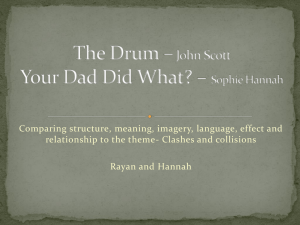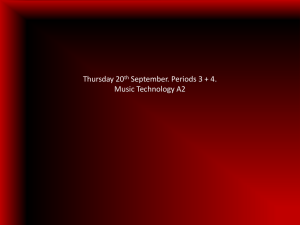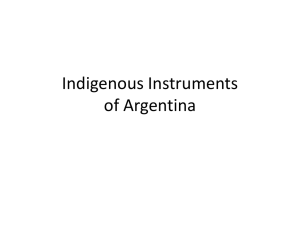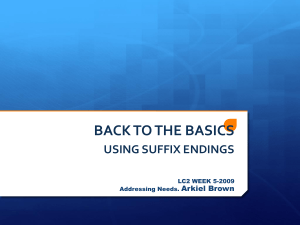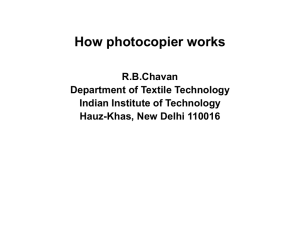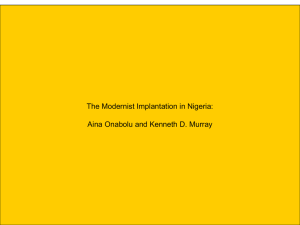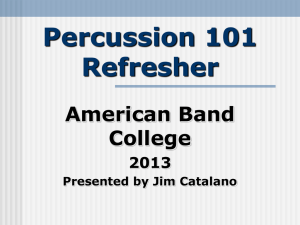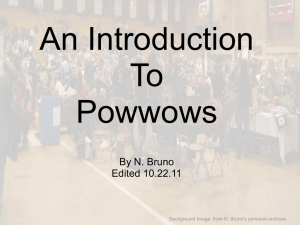Talking Drum. - WordPress.com
advertisement
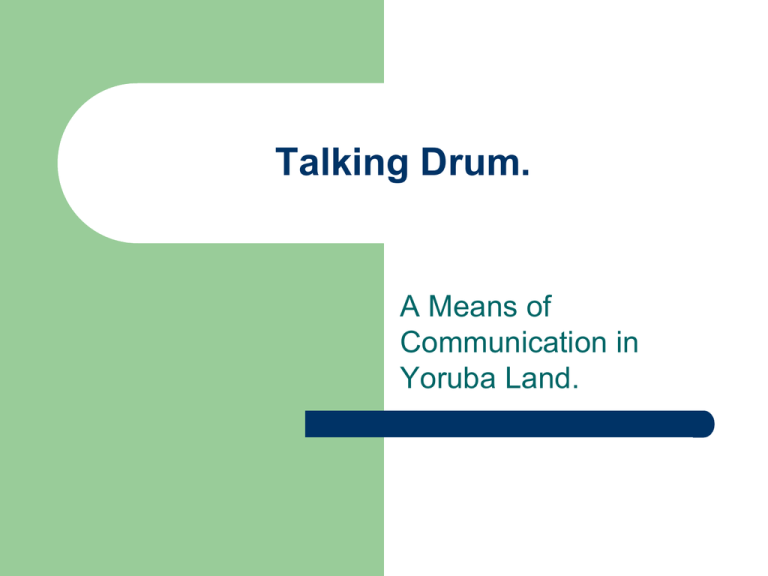
Talking Drum. A Means of Communication in Yoruba Land. Written By Ayodapo Ayansiji Oyelana May 2010 (c) Copyright Reserved 5 or 7 Continents of the world? There are 5 to 7 continents depending on how you count them Continents of the World 5 Continents Africa America Asia Australia Europe 7 continents of the world Africa Antarctica Asia Europe North America South America Oceania Africa has always been a continent Some people think Africa is a nation or country. No, Africa is a continent with several countries in her. . For example, Nigeria is a country in Africa Nigeria With a population of more than 113 million, Nigeria is easily the most populated country in Africa and the 10th most populous country in the world. Nigeria There are three main tribes: Hausa Ibo Yoruba Ethnic Groups There are more than 250 minor languages and ethnic groups under the three main ones Yoruba Tribe The Yorubas occupy the western part of Nigeria, the people in the west. The Yorubas are very rich in cultural values and heritage They have unique music, dance steps and drums like the other 2 main tribes. Yoruba Language Yoruba is a toner language There are three main tones in Yoruba language They are d r Do m Re Mi Three Main Tones Do, Re, Mi Form the basis of speech and names in Yoruba land Talking drumming also imitates after these three main tones. Although there are more tones in talking drum but these three main tones are showcased for this presentation. Talking Drum Talking drums are part of a family of hourglass shaped pressure drums. In the Yoruba language of west Africa, these include gangan, iya-ilu,kanango,omele (all known as dundun) The drummer showcases the talking drum types Gangan These are commonly played by the upper Yorubas of Igbominna, Ilorin and so on. They are showcased as “dadakúàdà” Playing Talking Drum The drum heads at either end of the drum's wooden body are made from hide, goat –skin (soft goat skin) or other membranes which are wrapped around a wooden hoop. Playing Talking Drum Leather cords or thongs (ọsán) made from the deer skin run the length of the drum's body and are wrapped around both hoops; when you squeeze these cords, the drum heads tighten, changing the instrument's pitch The Anatomy of a Talking Drum Talking Drum and Spoken Language Talking drum mimics the rhythms and intonations of spoken language. They can reproduce the sounds of proverbs or praise songs. Talking drum’s dialogue can be easily understood by a knowledgeable Yoruba audience. Talking Drum Patterns and Rhythms Talking drums can be played in various patterns and rhythms for different cultural activities i.e for spiritual ceremonies, rituals and praise chanting for the Yoruba traditional gods like Ògún, Ṣàngó, Ọ̀Ṣun etc. There are different rhythms played for these Yoruba deities. Talking Drum Patterns and Rhythms There are different patterns for celebrations, war, naming ceremony, burial, chieftaincy inaugurations, games and sports, rites of passage, healing, storytelling and initiation. Talking Drum Family (Ensemble) Generally the talking drum family can be categorized into two: Iya ilu (the mother drums/ lead drums) Omele (the followers /back ups or accompaniments The Iya Ilu - The Mother Drum / Leader This is the “commanding officer” of the talking drum ensemble; it leads the whole ensemble, as it talks, dictates the pace, determines the song and gives cues and prompts with its deep audible sound. The Iya Ilu - The Mother Drum / Leader It is easily distinguishable with “Ṣaworo” (brass rings) at both ends of the two faces of drum forming a semicircle, jingling while the iya-ilu is being played. Ṣaworo adds percussioning effects to the tune of iya ilu. The Iya Ilu - The Mother Drum / Leader Iya ilu is typically and skillfully played by a master talking drummer who is highly experienced and very seasoned. The master talking drummer must be versatile in other accompaniments to be able to skillfully lead a talking drum ensemble. Omele ( Followers / Accompaniment ) The Omele sub-group comprises of 1. ÌṢaájú 2. Àtẹ̀lé . . ÌṢaájú Isaju (fixed high pitched dundun) Its pitch is fixed to a high tone by tying the tension strings. This is always smaller The isaju literarily means "the one that leads” (in front) Àtẹ̀lẹ́ Atele (fixed low pitched dundun) By tying its tension strings, its pitch is fixed to a lower tone than the isaju. The Atẹle means "the one that follows the lead" The Àtẹ̀lé is lower than the Isaju The “Isaju” and “Atele” The more you tight, the higher the pitch Isaju and Atele Patterns These are same patterns played in different time, alternatingly i.e. Mi – mi Re- re Mi – mi Re- re -high pitch (low pitch) (high pitch) (low pitch) Mi-mi / re-re /mi - mi / re-re Gúdúgúdú/Ọmọle Depending on the size of the talking drum ensemble in Yoruba land, gudugudu or ọmọle is one of the main members of the ensemble. Ọmọle is a little kettle drum that combines the rhythms of both isaju and atẹle. It brings a melodious harmony to the dundun ensemble. Gudugudu/Ọmọle Player A skillful ọmọle player can substitute for both atele and isaju players. Big Ensemble There could be more than one set of each instrument described depending on the elaborate nature of the function or performance being used for. An example of such a big ensemble will be the type in a king’s palace or ceremonial occasion Big Ensemble There can be 5 iya ilu drummers – – – – – (one of them will be the main lead) There will be just only 1 isaaju There could be many atele 1 kẹríkẹrì Many gúdúgúdú(s) Sekere and Aro These are other members of the big ensemble family of Yoruba talking drum Ṣẹ̀kẹ̀rẹ̀ The Ṣẹkẹrẹ players are known as the song leaders. They echo the songs or chants of a lead talking drummer. Aro Aro are a pair of metal gongs that rub against each other. Prompting/Cautionary Measure Talking drummers use talking drum to converse, instruct and caution themselves especially during performances. Question Time Can anyone play this instrument? Answer Yes. As long as you are familiar with the basic rhythmic patterns You have a drum, and ready to take lessons, you can play talking drum. Let’s Play Let’s play The end Thank you. References www.africaguide.com Ayodapo Ayansiji Oyelana, Lead Talking Drummer, April 2010 Chernoff, John. African Rhythm and African Sensibilitiy: Aesthetics and Social Action in African Musical Idioms. Chicago: University of Chicago Press, 1979 References Gbeminiyi Akintunde, Music Department, Obafemi Awolwowo University, April, 2010 Jonathan Ayanwale Murray, Multicultural Percussionist/Drummer, FunDrum Rhythm Circles, USA http://Kanyinsola.com www.lagbaja.com References Cont.: Locke, David. Drum Damba: Talking Drum Lessons. Crown Point, Ind: White Cliffs Media, 1990. http://www.si.umich.edu/chico/instrument/pages/tlkdr um_gnrl.html Waterman, Christopher A. Juju: A Social History and Ethnography of an African Music. Chicago: University of Chicago Press, 1990.
